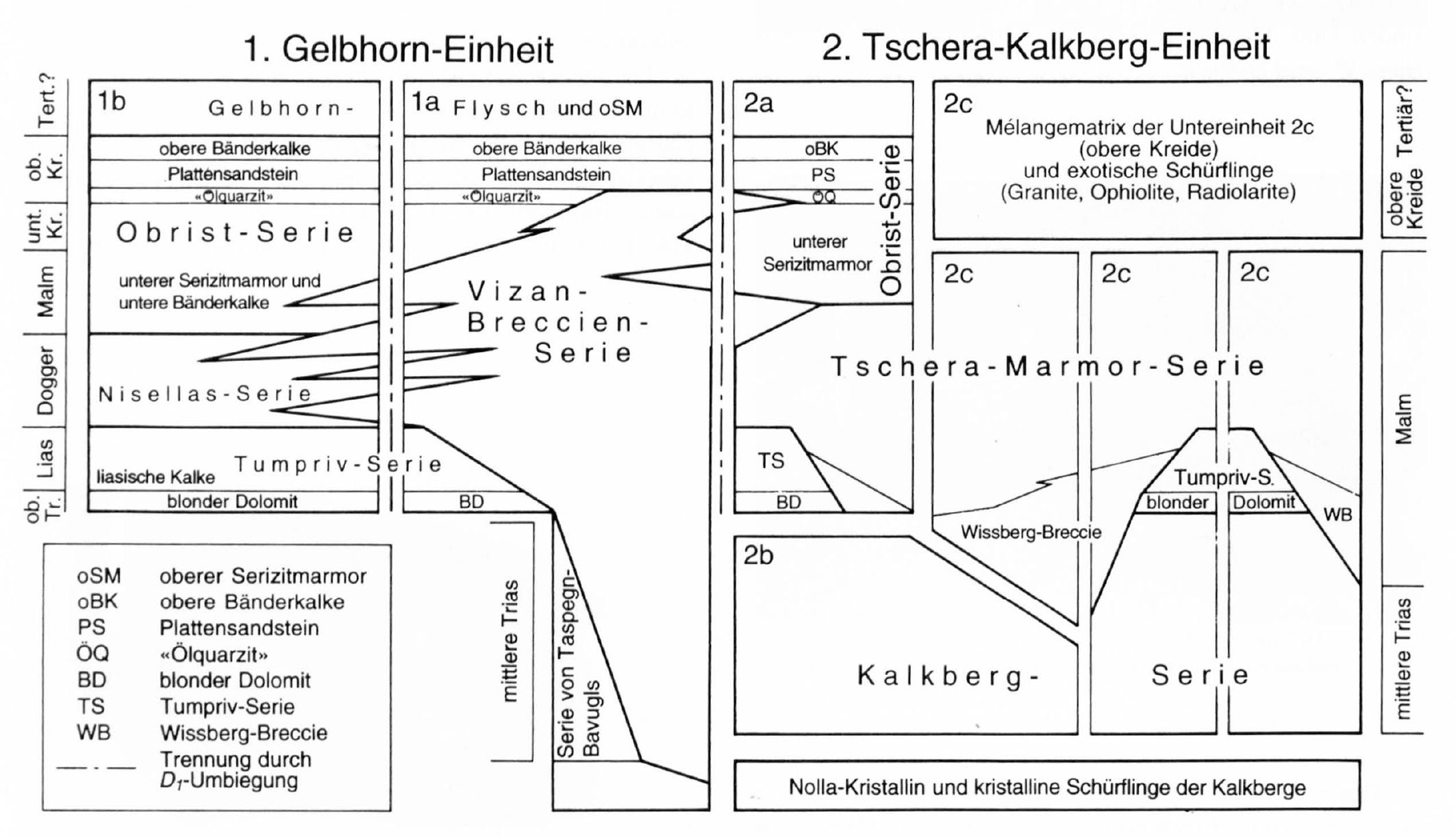-
Schams-Deckenkomplex
- Origin of the Name
-
Schams = Val Schons (GR), Hinterrheintal
- Rank
- nappe complex
- Status
- valid
- Age
- Carboniferous - Eocene
- In short
-
The Schams Nappe Complex is a Middle Penninic tectonic unit of eastern Switzerland encompassing a set of small nappes, which were folded after their emplacement around the Tambo-Suretta pair during the Niemet-Beverin post-nappe folding. The Schams Nappe Complex also contains different mélanges: to the west, in the lower limb of the Niemet-Beverin Backfold, the Knorren Mélange is in contact with the Tambo Nappe, while the Areua-Bruschghorn Mélange marks the boundary with the Tomül Nappe; to the east, in the upper (overturned) limb of the Niemet-Beverin Backfold, the Martegnas Mélange is in contact with the Arblatsch Flysch belonging to the Tomül Nappe.
The sedimentary sequences of the Schams Nappe Complex exhibit large facies variations and are rich in sedimentary syn-rift breccias of Middle Jurassic to Early Cretaceous age, indicating contemporaneous extension and sinistral strike-slip. The mid-Cretaceous to Cenozoic post-rift sediments are very similar to those found in the Falknis Nappe. Retrodeformation suggests that the Schams nappes formerly occupied an area north of the depositional area of the Tambo and Suretta Mesozoic. This is supported by facies arguments indicating that sediments in the originally northernmost paleogeographical position (now forming the Gelbhorn Nappe) suggest N-directed shedding of syn-rift breccias, and by the Subbriançonnais-type facies of the Triassic strata.
-
Gelbhorn-Decke
- Origin of the Name
- Rank
- nappe
- Status
- valid
- In short
-
The Gelbhorn Nappe is part of the Schams Nappe Complex. In the hanging wall of the Suretta Nappe (eastern Shams), the outer, fine-grained, calcareous limb of the unit (1b) is normal, while the inner, coarse-grained limb (1a) is overturned on the Tschera-Kalkberg Nappe. In the Westschams, and thus in the footwall of the Suretta Nappe, the structural situation is the other way round, i.e. the outer limb is overturned and the inner limb is normal.
-
Tschera-Kalkberg-Decke
- Rank
- nappe
- Status
- valid
- In short
-
The Tschera-Kalkberg Nappe is a tectonically complex, mélange-like inner sheath of the Schams Nappe Complex. It is divided into three subunits based on lithological criteria.
-
Bandfluh-Schuppe
- Name Origin
-
Bandfluh = Bandflue (GR), Avers
- Rank
- tectonic slice
- Status
- local name (informal)
- Age
- Ladinian
-
Areua-Bruschghorn-Melange
- Origin of the Name
- Rank
- tectonically bounded lithostratigraphic unit
- Status
- informal term
- Age
- Paleozoic - Early Triassic
- In short
-
The Areua-Bruschghorn Mélange is a tectonic mélange situated in the lower limb of the Niemet-Beverin Backfold, at the contact between the Schams Nappe Complex and the Tomül Nappe.
- Nomenclatorial Remarks
-
Das im Westschams vorkommende Areua-Bruschghorn-Melange lässt sich über das Scharnier der liegenden Niemet-Beverin-Falte mit dem Martegnas-Melange im Ostschams verbinden.
-
Bruschghorn-Schuppe
- Name Origin
- Rank
- tectonic slice
- Status
- local name (informal)
- In short
-
Gneis, Dolomit, Gips und Prasinit.
-
Burgruinen-Gneis
- Name Origin
- Rank
- lithostratigraphic Formation
- Status
- informal term
- In short
- Hellgrauer, quarzreicher Orthogneis mit charakteristischen dunkelgrauen Feldspäten. Das Gestein ist von Quarzgängen (Pegmatit) durchsetzt.
-
Martegnas-Melange
- Origin of the Name
-
Piz Martegnas (GR), Oberhalbstein
- Rank
- tectonically bounded lithostratigraphic unit
- Status
- local name (informal)
- In short
-
The Martegnas Mélange is a tectonic mélange situated in the upper (overturned) limb of the Niemet-Beverin Backfold, at the contact between the Schams Nappe Complex and the Arblatsch Flysch (Tomül Nappe).
- Nomenclatorial Remarks
-
Das im Ostschams vorkommende Martegnas-Melange lässt sich über das Scharnier der Niemet-Beverin-Falte mit dem Areua-Bruschghorn-Melange im Westschams verbinden.
- Skip to home page (press enter)
- Skip to main navigation (press enter)
- Skip to main content (press enter)
- Skip to contact page (press enter)
- Skip to search page (press enter)

